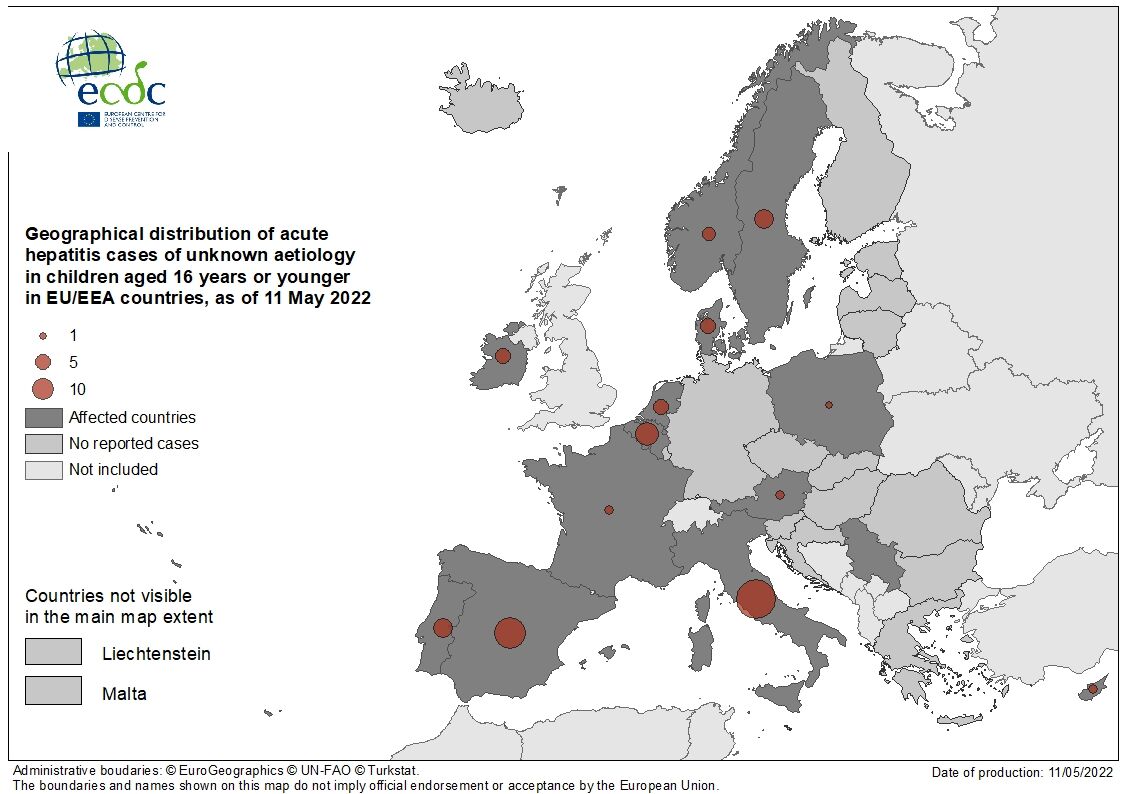Epidemiological update: Hepatitis of unknown aetiology in children
Since the first alert launched by the United Kingdom (UK) on 5 April 2022, probable cases of hepatitis of unknown aetiology in children have been reported from several countries worldwide. It is not yet clear whether the cases identified following the alert are part of a true increase compared to the baseline rate of hepatitis of unknown aetiology in children.
The aetiology and pathogenetic mechanisms of disease are still under investigation. A possible association with current adenovirus infection has been found in cases in the UK in particular but other hypotheses and possible co-factors are under investigation. Most cases continue to be reported as sporadic un-linked cases.
This report presents an update of probable cases identified in the European Union/European Economic Area (EU/EEA) and worldwide. Whereas cases detected in the EU/EEA have been reported according to the ECDC/WHO case definition, worldwide cases are collected through screening of official websites and media sources and therefore different case definitions could have been used.
Case definition used in EU/EEA:
- Confirmed: N/A
- Probable: A person presenting with an acute hepatitis (non-hepatitis viruses A, B, C, D and E*) with aspartate transaminase (AST) or alanine transaminase (ALT) over 500 IU/L, who is 16 years old or younger, since 1 October 2021.
- Epi-linked: A person presenting with an acute hepatitis (non-hepatitis viruses A, B, C, D and E*) of any age who is a close contact of a probable case since 1 October 2021.
Cases of hepatitis with known aetiology such those due to specific infectious diseases, drug toxicity, and metabolic hereditary, or autoimmune disorders should not be reported under this protocol.
In EU/EEA countries, approximately 105 cases have been identified in 13 EU/EEA countries as of 10 May 2022.
Table 1. Number of identified cases by country, EU/EEA, 10 May 2022
|
Country |
Cases |
|---|---|
|
Austria |
2 |
|
Belgium |
3 |
|
Cyprus |
2 |
|
Denmark |
6 |
|
France |
2 |
|
Ireland |
Fewer than 5 |
|
Italy |
35 |
|
Netherlands |
6 |
|
Norway |
4 |
|
Poland |
1 |
|
Portugal |
8 |
|
Spain |
22 |
|
Sweden |
9 |
|
Total |
Between 102 and 106 |
Figure 1. Geographical distribution of cases in EU/EEA, 11 May 2022

Worldwide update
United Kingdom: As of 3 May 2022, the UKHSA has identified a total of 163 children, aged under 16 years, with acute hepatitis of unknown aetiology. Of these cases, 11 children have received a liver transplant. A second detailed technical briefing on the investigations among the UK cases was published by the UKHSA on 6 May 2022.
Outside of EU/EEA and the United Kingdom: as of 10 May 2022, there are at least 181 cases of acute hepatitis among children. Cases have been reported by Argentina [8], Brazil [16], Canada [7], Costa Rica [2], Indonesia [15], Israel [12], Japan [7], Panama [1], Palestine* [1], Serbia [1], Singapore [1], South Korea [1] and the United States [at least 109].
The total number of cases reported worldwide is approximately 450, including 11 deaths reported from Indonesia [5], Palestine [1], and the United States [5].
On 3 May 2022, the media quoting public health authorities reported a death of an eight-year-old child with acute hepatitis of unknown aetiology in Palestine*. It is currently unclear whether this is the same child who was diagnosed in the previous week. Confirmation of this case is pending.
*This designation shall not be construed as recognition of a State of Palestine and is without prejudice to the individual positions of the Member States on this issue.
Actions: On 28 April 2022, ECDC published a rapid risk assessment. ECDC has established reporting of case-based data for cases of acute hepatitis of unknown aetiology in The European Surveillance System (TESSy). The reporting protocol is available here, and countries are strongly encouraged to report cases to TESSy. A separate report based on the data reported in TESSy will be published shortly.
An EpiPulse item remains available to Member States (MS) to report updates on their investigations in order to inform and facilitate communication between MS and ECDC.
ECDC will continue to monitor this event through its epidemic intelligence activities.
Disclaimer: Data presented in this update are compiled from official national reports or, if not available, from public sources quoting national authorities. Where possible, cases are classified according to the EU/EEA case definition. Media reports might not include complete information on testing, so classification of cases is not always possible. These are presented as ‘cases under investigation’. Data include both probable cases, according to the case definition used in the EU/EEA, and cases under investigation. In some cases, the testing strategy has not been officially confirmed.







